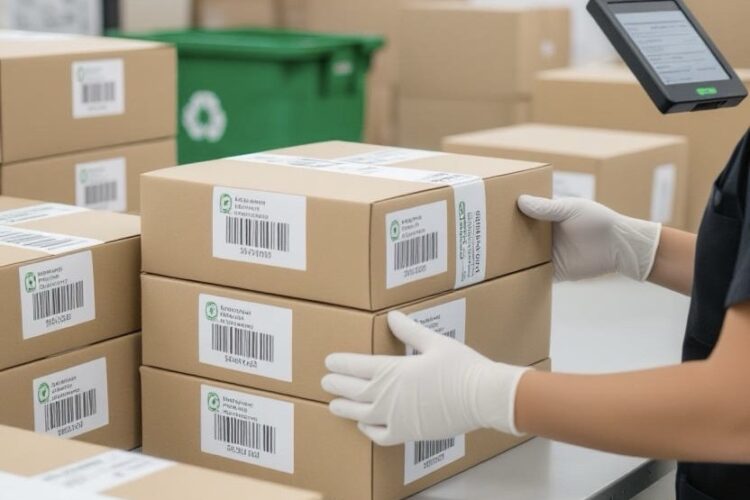Direct thermal shipping labels, vital for logistics, use heat-sensitive coatings for printing without ink. However, traditional labels often contain toxic Bisphenol A (BPA), Bisphenol S (BPS), and phenols, which act as color developers but pose health risks like hormonal disruption, reduced fertility, and links to cancer through skin absorption, especially for cashiers, pregnant women, and infants. These chemicals also harm the environment via landfill runoff and complicate recycling. Non-toxic, BPA-free, BPS-free, and phenol-free alternatives, using ascorbic acid or urea-based developers, ensure safety and sustainability. Regulations like California’s Proposition 65 and EU bans drive adoption, while innovations like linerless and dissolvable labels reduce waste. These labels maintain print quality, comply with laws, and enhance brand image by prioritizing health and eco-friendliness, supporting safer workplaces and a shift to digital receipts.
Long Version
The Critical Role of Non-Toxic, BPA-, BPS-, and Phenol-Free Direct Thermal Shipping Labels in Safeguarding Health
Direct thermal shipping labels are essential in modern logistics, enabling efficient thermal printing for packages, receipts, and point-of-sale systems. These labels rely on a heat-sensitive layer that darkens when exposed to heat from a thermal printer, eliminating the need for ink or ribbons. However, traditional label coatings often contain hazardous chemicals like Bisphenol A (BPA), Bisphenol S (BPS), and other phenols, which serve as color developers to produce clear images. While effective for producing durable shipping labels, these compounds raise serious concerns about human health, safety, and environmental impact, prompting a shift toward non-toxic, BPA-free, BPS-free, and phenol-free alternatives.
BPA, a widely used chemical also found in polycarbonate plastics, epoxy resins, food can linings, and flame retardants, has been linked to significant health risks through skin absorption. When handling direct thermal labels, exposure occurs via contact, especially under conditions like wet fingers, greasy fingers, or after using alcohol sanitizer, which can enhance absorption. As endocrine disruptors, BPA and BPS mimic estrogen, leading to hormonal disruption and estrogen mimicry that affect reproductive health, including reduced fertility and developmental effects on fetal development. Studies show associations with breast cancer, prostate cancer, obesity, and attention disorders, with over 100 epidemiology reports indicating adverse outcomes from BPA exposure. High-risk populations, such as pregnant women, nursing women, infants, and toddlers, face amplified dangers due to their vulnerability to these effects. Cashier exposure is particularly concerning, as frequent handling in retail environments can lead to elevated levels, exacerbated by hand-to-mouth behaviors.
BPS, often introduced as a BPA substitute in thermal paper, shares a similar structure and poses comparable risks, including reproductive system hazards and links to thyroid issues. Bisphenol F (BPF), another phenol variant, is emerging as a concern in some formulations. Exposure levels are measured in micrograms per square centimeter, and while the FDA’s safety assessment sets a tolerable daily intake (TDI), real-world handling often exceeds safe thresholds, especially in occupational settings. These chemicals disrupt normal growth, immunity, and endocrine functions, making non-toxic options vital for consumer products like shipping labels and receipts.
Beyond health, the environmental impact of BPA and BPS in direct thermal labels is profound. These compounds leach into landfill runoff and wastewater contamination during recycling or disposal, harming aquatic life and contaminating other papers in the stream. Thermal paper recycling is complicated by these phenols, which persist in the environment and contribute to broader pollution from manufacturing to end-of-life. Sustainability demands alternatives that minimize such hazards, aligning with goals for biodegradable paper and compostable paper.
Regulations are driving change. California’s Proposition 65 requires warning labels for products containing BPA or BPS, with notices surging for thermal labels and receipts. Effective December 29, 2024, consumer goods in California must comply, and Washington State bans bisphenols in thermal paper starting January 1, 2026, prohibiting manufacture, sale, or distribution. The EU’s REACH regulation and ban on BPA in thermal paper since 2020 set global precedents, while the EPA identifies 19 BPA alternatives for evaluation. Compliance ensures regulatory adherence and avoids penalties, with third-party testing and product certifications verifying safety.
Phenol-free direct thermal labels offer robust alternatives, using non-toxic color developers like ascorbic acid, vitamin C developers, or urea-based Pergafast 201. Innovations such as Blue4est from NCCO and Appvion’s vitamin C-based papers provide high-performance options without phenols. Companies like Bayscan, Beagle Hardware, Excellent Packaging and Supply, Paper Roll Products, Beontag, HERMA, Kanzaki, and Vitex produce these, often with recyclable liners, PFAS-free, and phthalates-free compositions. Linerless labels and dissolvable labels further enhance sustainability, reducing waste while maintaining crisp printing for barcodes and shipping details.
The benefits extend to enhanced brand image, as businesses adopting these labels demonstrate commitment to safety and environmental stewardship. They deliver superior printability, scannability, and durability against heat, matching or exceeding traditional papers without health trade-offs. For employees and consumers, this means reduced exposure to hazardous chemicals, fostering healthier workplaces and supply chains. Transitioning is straightforward, with no changes needed in printing processes, and it supports broader shifts to e-receipts and digital receipts to minimize paper use altogether.
In summary, prioritizing non-toxic, BPA-, BPS-, and phenol-free direct thermal shipping labels is essential for mitigating health risks, ensuring regulatory compliance, and promoting sustainability. By embracing these innovations, industries can protect vulnerable groups, reduce environmental contamination, and build trust through safer consumer products.
Hashtags For Social Media
#BPAFree #NonToxicLabels #ThermalLabels #EcoFriendly #SafeShipping #HealthyLiving #GreenPackaging #PhenolFree #BPSFree #SustainableLabels #HealthSafety #EcoLabels #GreenLiving #SafeLabels #NoBPA #HealthyChoices #EnvironmentallyFriendly #ThermalPrinting #NonToxic #GreenBusiness #LabelSafety #EcoFriendlyPackaging #HealthFirst #SustainableBusiness #SafePackaging #NoToxins #GreenProducts #HealthyWorkplace #EcoShipping #CleanLabels
Related Questions, Words, Phrases
why are bpa-free shipping labels important | what are non-toxic thermal labels | how do bpa and bps affect health in labels | are direct thermal labels safe | why choose phenol-free shipping labels | what chemicals are in thermal shipping labels | how to avoid bpa in shipping labels | health risks of bpa in thermal paper | benefits of bpa-free thermal labels | are bps-free labels better for health | what is a phenol-free label | why is bpa harmful in shipping labels | how to find non-toxic shipping labels | impact of bpa on cashier health | are thermal labels eco-friendly | what are bpa-free label alternatives | how does bpa affect pregnant women | why use non-toxic thermal paper | health dangers of bps in labels | how to choose safe shipping labels | what regulations cover bpa in labels | are phenol-free labels sustainable | how bpa in labels affects hormones | what are safe thermal label materials | why avoid phenols in shipping labels | how to reduce bpa exposure from labels | are bpa-free labels required by law | what is bps in thermal shipping labels | health benefits of phenol-free labels | how to identify non-toxic labels | why are bpa-free labels eco-friendly | impact of thermal labels on infants | what are vitamin c-based thermal labels | how do linerless labels reduce waste | why switch to bpa-free thermal printing






